Orthodontics
Orthodontics
Dr. Mirzaeian's family office in Clovis is here to provide world-class smiles! When you visit our office, your comfort and your orthodontic care is our top priority. Our entire team is dedicated to providing you with the personalized, gentle care that you deserve and to giving you a beautiful smile.Our orthodontist office is located at 1592 Shaw Ave Clovis, CA serves Fresno, Clovis, Madera, Sanger, Dinuba, Kerman, Selma, Reedley, and all of the surrounding communities..
Office hours are Monday through Saturday 8 am to 5 pm.
If your desire is to straighten crooked teeth or a misaligned jaw, braces may be the answer you're looking for. Braces work by applying pressure to the teeth and jaws in order to move them into a desired position.
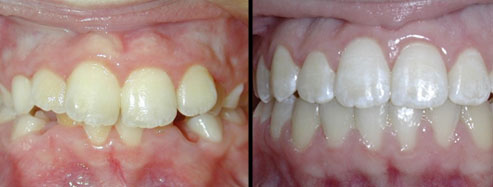
Changes in Orthodontic Technology
Braces are not the shiny mouthful of metal of years past. Many more options are now available. Teeth used to be fully banded. But today, brackets are bonded directly to each tooth's surface. With some people it's possible to place them behind the teeth, making them less noticeable.Braces can be made with materials such as:
- Stainless steel
- Ceramic
- Plastic
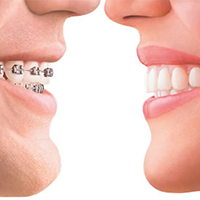
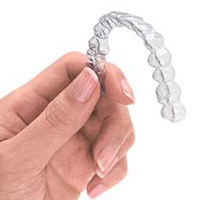
Invisalign
Clear, invisible "trays" are also now available. These can straighten teeth without using traditional braces and wires.Invisible trays may be an option for people who require simple orthodontic work. This method uses custom-made, clear, removable trays that put pressure on the teeth, moving them gradually into their correct position. This treatment is not right for people requiring more extensive orthodontic work.
Frequently Asked Questions
For your convenience, we’ve answered some of the most frequently asked questions about orthodontics here. If your question is not answered here — or even if it is and you need additional help and guidance — please call us at (559) 299-2168.What does an orthodontist do?
An orthodontist is a dentist who has received advanced specialty training to diagnose, prevent, and treat dental and facial irregularities. Some of the conditions orthodontists commonly treat include crooked teeth, crowded teeth, and misaligned jaws.Orthodontists use various tools and techniques to straighten teeth, improve jaw alignment, and create a healthy, functional bite. These tools may include braces, clear aligners, and other orthodontic appliances.
Orthodontic treatment can help improve the appearance of your smile, as well as your oral health and overall well-being.
However, it's important to note that not all dentists are orthodontists, and not all orthodontic treatment is done by orthodontists. Some general dentists, like your local family dentist, may offer certain orthodontic services, like Invisalign, but for more complex orthodontic cases, you may be referred to an orthodontist for treatment.

What is a dentist vs orthodontist?
Both dentists and orthodontists are doctors specializing in oral health care.A dentist specializes in the diagnosis, prevention, and treatment of conditions that affect the teeth, gums, and mouth. Dentists may provide a range of services, including routine cleanings, fillings, root canals, extractions, and more … including some orthodontic services.
On the other hand, an orthodontist is a dental specialist who focuses on the alignment of the teeth and jaws. Orthodontists receive specialized training and education beyond dental school to learn how to diagnose and treat a wide range of orthodontic issues, including misaligned teeth and jaws, crowding, and bite problems.
Your local family dentist may offer certain orthodontic services — like Invisalign — and will refer you to an orthodontist if your condition is more complex or if it requires specialized treatment.

Is it better to get braces from a dentist or orthodontist?
Both dentists and orthodontists are doctors specializing in oral health care.For example, if you have a mild case of crooked teeth or a small gap between your teeth, your family dentist may be able to provide treatment using Invisalign or other simple orthodontic appliances.
You might also choose to get simple orthodontic treatment from your dentist because of your existing relationship with them. It may feel more comfortable and be more convenient to receive treatment in their office rather than visiting a separate orthodontic practice.
Your dentist can help you determine whether you’re a candidate for getting braces from them or if you need a referral to an orthodontist instead.
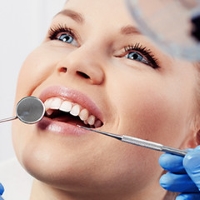
How much do braces cost?
The cost of braces can vary widely depending on several factors, such as the type of braces you choose, the length of treatment, and the complexity of your orthodontic needs.Here are some average costs, according to ConsumerAffairs:
- Traditional metal braces: $3,000-$7,000
- Self-ligating braces: $3,000-$7,000
- Ceramic braces: $4,000-$8,500
- Lingual braces: $5,000-$13,000
- Headgear braces: up to $9,000
Your family dentist or orthodontist can provide you with a more detailed estimate of the cost of braces based on your individual needs and circumstances.
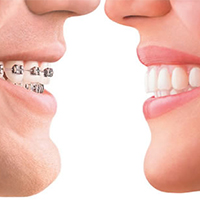
How much does Invisalign cost?
According to ConsumerAffairs, the average cost of Invisalign is $3,400. In some cases, that can go up to $8,500 or more, depending on how extensive your treatment needs are.Your family dentist or orthodontist can provide you with a more detailed estimate of what your particular cost of Invisalign would be based on your individual needs and circumstances.
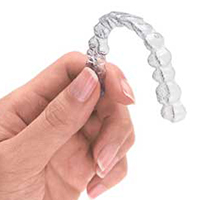
What are the benefits of straight teeth?
While perhaps the most obvious benefits of having straight teeth are a beautiful smile and self-confidence, there also are a number of health benefits you get from straight teeth.For example, straight teeth are easier to clean and maintain. When teeth are crooked or overlapping, it can be difficult to clean between them properly. This can lead to a buildup of plaque and bacteria, which can cause gum disease and tooth decay.
And research has shown that gum disease can increase your risk of developing other health problems, such as heart disease, high blood pressure, rheumatoid arthritis, dementia, and diabetes. By keeping your teeth straight and healthy, you can reduce your risk of developing and/or controlling these serious health conditions.
Having straight teeth also can improve your bite and jaw alignment. When teeth are crooked or misaligned, it can cause problems with your bite, such as overbite, underbite, or crossbite. These bite problems can lead to headaches, jaw pain, and even difficulty eating or speaking. By straightening your teeth and improving your bite, we can help alleviate these issues.

What age is the best age to get braces?
The best age to get braces can vary depending on the individual's dental needs and their stage of dental development. However, in general, it's recommended to get braces between the ages of 10 and 14, when the jaw is still growing and the teeth are more receptive to correction.However, it's never too late to get braces. Even as an adult, you can still benefit from orthodontic treatment. In fact, more and more adults are opting for braces or clear aligners like Invisalign to improve their smile and oral health.

Do I really need to wear my retainers for the rest of my life?
In most cases, you do NOT need to wear retainers for the rest of your life after having your teeth straightened with braces. In general, retainers are worn full-time for several months after the braces are removed, and then gradually reduced to nighttime wear only.The reason for this is that teeth have a tendency to shift back towards their original positions after braces are removed. Retainers help to hold the teeth in their new positions while the bone and tissue around them stabilize. Without retainers, the teeth can begin to shift, potentially undoing the effects of the braces.
It’s generally recommended that you wear retainers for at least a year after the braces have been removed, but in some cases a longer amount of time is needed. Your dentist or orthodontist can tell you how long you should wear retainers in your specific case.
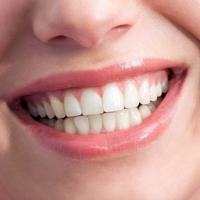
How long does it take to straighten teeth with braces?
The length of time it takes to straighten teeth with braces can vary for each individual. Some of the determining factors include the severity of the dental problem, the type of braces used, and the patient's age and overall oral health.However, in general, braces are typically worn for about 18 to 24 months.
If you're considering braces, it's important to discuss the treatment timeline and any concerns or questions you may have with your dentist or orthodontist. They can provide you with more specific information based on your individual needs and help you make an informed decision about your treatment options.

Can anyone get Invisalign?
In general, Invisalign can be an effective treatment option for almost anyone with a wide range of dental problems, including crooked teeth, crowded teeth, gaps between teeth, and bite problems.However, not everyone is a good candidate for Invisalign. In some cases — like severe bite problems, significant overcrowding, or people with TMJ disorder — traditional braces or other orthodontic treatments may be a better option.
The best way to determine if Invisalign is right for you is to schedule a consultation with a dentist or orthodontist who offers Invisalign, like Dr. Lovik Mirzaeian. We can evaluate your individual case and recommend the best course of treatment to help you achieve the smile you've always wanted.
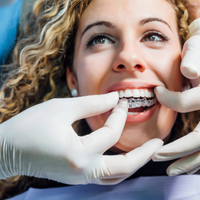
Do braces cause more plaque?
While braces can help improve the appearance and functionality of teeth, they can also make it harder to clean the teeth properly while wearing them. And this can lead to an increased risk of plaque buildup.This is because when braces are placed on the teeth, they create small crevices and spaces where plaque can easily accumulate and be difficult to remove with regular brushing and flossing.
Plaque forms when bacteria that’s naturally present in the mouth attaches to the surface of teeth and begin to multiply. When we don’t brush and floss properly — or when we can’t because braces are in the way — the bacteria continues to multiply and becomes plaque.

How do I keep plaque from building up around my braces?
ITo combat the increased risk of plaque buildup, it is essential to maintain good oral hygiene habits while wearing braces. This includes brushing twice a day with a soft-bristled toothbrush and fluoride toothpaste, flossing at least once a day, and using an interdental brush or water flosser to clean around the brackets and wires.It also is recommended that people with braces avoid consuming sugary and/or acidic foods and drinks, which can increase the risk of tooth decay and erosion.
Regular dental checkups and cleanings with a dental professional can also help prevent plaque buildup and ensure that the braces are properly adjusted and maintained.
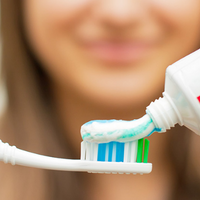
Do orthodontic braces hurt?
Orthodontic braces can cause some discomfort or soreness, especially in the first few days after they are placed on the teeth or adjusted. This discomfort is usually mild and can be managed with over-the-counter pain relievers or by using orthodontic wax to cover any brackets or wires that are rubbing against the cheeks or lips.Some people may experience more significant pain or soreness than others. This is because the teeth and jaws are being shifted into a new position, and the braces are applying pressure to move them. However, the discomfort should subside within a few days and can be managed with pain relievers or by eating softer foods.
It is important to note that any significant or persistent pain or discomfort should be reported to your orthodontist, as it could indicate a problem with the braces or require adjustments to the treatment plan.

Why should I get orthodontic treatment?
There are many reasons why people get orthodontic treatment. Some of those reasons include:- Improving the appearance of their smile. Crooked, crowded, or misaligned teeth can affect the appearance of your smile and may make you feel self-conscious.
- Correcting bite problems. Bite problems, such as overbites, underbites, and crossbites, can affect the way the teeth come together when biting and chewing and may lead to jaw pain or other oral health problems.
- Preventing oral health problems. Teeth that are crooked or crowded can be more difficult to clean properly, which can increase the risk of tooth decay, gum disease, and other oral health problems.
- Improving speech and chewing ability. Bite problems or misaligned teeth can affect a person's ability to speak or chew properly, which can impact their overall quality of life.
- Addressing jaw pain or discomfort. Orthodontic treatment also can help correct jaw alignment issues and alleviate pain or discomfort caused by jaw problems.
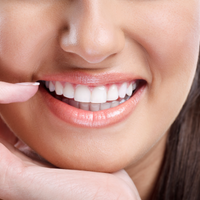
How can I recognize a potential bite problem?
Early detection and treatment of bite problems can help prevent more serious oral health problems in the future. So, it’s important to consult with a qualified dentist or orthodontist if you notice any of these signs and symptoms that may indicate a potential bite problem:- Crowded or crooked teeth
- Difficulty chewing or biting
- Mouth breathing
- Speech difficulties
- Grinding or clenching teeth
- Jaw pain or discomfort, or difficulty opening or closing your mouth
- Headaches, particularly in the temple or jaw area


